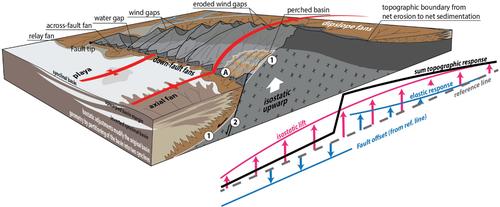当前位置:
X-MOL 学术
›
Basin Res.
›
论文详情
Our official English website, www.x-mol.net, welcomes your
feedback! (Note: you will need to create a separate account there.)
Geomorphological traits of landscapes in continental rifts—From fault‐elastic rebound to sedimentary sinks
Basin Research ( IF 2.8 ) Pub Date : 2024-07-06 , DOI: 10.1111/bre.12881 Alvar Braathen 1 , Ivar Midtkandal 1 , Per Terje Osmundsen 2
Basin Research ( IF 2.8 ) Pub Date : 2024-07-06 , DOI: 10.1111/bre.12881 Alvar Braathen 1 , Ivar Midtkandal 1 , Per Terje Osmundsen 2
Affiliation

|
We analyse 498 faults identified in satellite imagery and interpret the height and width of associated footwall ranges with respect to co‐seismic elastic rebound from tectonic and erosional unloading. The dynamics of footwall uplift link uplands to catchment patterns and interrelated hanging wall sedimentary fans. Height–length relations of some catchments and associated alluvial fans scale linearly whereas others, such as fault‐slope catchments and related down‐fault fans (building out from faults) show a significant scatter without an obvious trend. Perched basins abandoned in the footwalls of younger faults offer catchment‐fan height–length relations like watergap and dipslope‐related fans and, besides, hint at reduction of dip angle due to rollback of larger faults before abandonment. Analysis of the width‐to‐height ratio (W /h ) of footwall ranges offer a robust linear statistical trend, h = 0.06 W and is identical between datasets. This trend is valid for both arid and tropical rifts, the latter offering smaller rebounds. Contributions of elastic rebound on fault throw in our data are simplistically considered through comparison to global trends on fault length versus throw. This allows consideration around maximum throw (T max ) linked to the maximum height of footwall ranges (h ) and to their width (W ) above the reference level. Basic calculations indicate that co‐seismic rebound contributes from <1% to 17% of extensional fault throw. Width‐to‐height ratios for large faults (L > c. 50 km) show less spread than smaller faults. Such large faults expectedly dissect the brittle crust, indicating that these large faults which root in the ductile–brittle transition approach a balanced, steady‐state kinematic pattern. We speculate that significant crustal thinning associated with these large faults triggers the onset of isostatic adjustments that drive fault rotation, instigating fault abandonment and disconnected perched basins.
中文翻译:

大陆裂谷地貌地貌特征——从断层弹性回弹到沉积汇
我们分析了卫星图像中发现的 498 个断层,并根据构造和侵蚀卸荷的同震弹性回弹解释了相关下盘范围的高度和宽度。下盘隆起的动力学将高地与流域模式和相互关联的上盘沉积扇联系起来。一些流域和相关冲积扇的高度-长度关系呈线性比例,而其他流域,例如断层斜坡流域和相关的断层扇(由断层构建)则显示出显着的分散性,而没有明显的趋势。废弃在较年轻断层下盘的栖息盆地提供了集水扇高度-长度关系,如水隙和倾斜相关扇,此外,还暗示由于废弃前较大断层的回滚而导致倾角减小。对下盘范围的宽高比 (W/h) 的分析提供了稳健的线性统计趋势,h = 0.06 W,并且在数据集之间是相同的。这一趋势对于干旱和热带裂谷均有效,后者提供的反弹较小。我们的数据中,通过与断层长度与断距的全球趋势进行比较,简单地考虑了弹性回弹对断层断距的贡献。这允许考虑与下盘范围的最大高度 (h) 及其在参考水平之上的宽度 (W) 相关的最大投掷 (Tmax)。基本计算表明,同震回弹对伸展断层断距的贡献从 <1% 到 17%。大断层(L > c. 50 km)的宽高比显示出比较小断层的传播范围更小。如此大的断层预计会解剖脆性地壳,这表明这些源于韧性-脆性转变的大断层接近平衡、稳态的运动学模式。 我们推测,与这些大断层相关的地壳显着减薄会触发均衡调整的开始,从而驱动断层旋转,引发断层废弃和断开的栖息盆地。
更新日期:2024-07-06
中文翻译:

大陆裂谷地貌地貌特征——从断层弹性回弹到沉积汇
我们分析了卫星图像中发现的 498 个断层,并根据构造和侵蚀卸荷的同震弹性回弹解释了相关下盘范围的高度和宽度。下盘隆起的动力学将高地与流域模式和相互关联的上盘沉积扇联系起来。一些流域和相关冲积扇的高度-长度关系呈线性比例,而其他流域,例如断层斜坡流域和相关的断层扇(由断层构建)则显示出显着的分散性,而没有明显的趋势。废弃在较年轻断层下盘的栖息盆地提供了集水扇高度-长度关系,如水隙和倾斜相关扇,此外,还暗示由于废弃前较大断层的回滚而导致倾角减小。对下盘范围的宽高比 (W/h) 的分析提供了稳健的线性统计趋势,h = 0.06 W,并且在数据集之间是相同的。这一趋势对于干旱和热带裂谷均有效,后者提供的反弹较小。我们的数据中,通过与断层长度与断距的全球趋势进行比较,简单地考虑了弹性回弹对断层断距的贡献。这允许考虑与下盘范围的最大高度 (h) 及其在参考水平之上的宽度 (W) 相关的最大投掷 (Tmax)。基本计算表明,同震回弹对伸展断层断距的贡献从 <1% 到 17%。大断层(L > c. 50 km)的宽高比显示出比较小断层的传播范围更小。如此大的断层预计会解剖脆性地壳,这表明这些源于韧性-脆性转变的大断层接近平衡、稳态的运动学模式。 我们推测,与这些大断层相关的地壳显着减薄会触发均衡调整的开始,从而驱动断层旋转,引发断层废弃和断开的栖息盆地。

































 京公网安备 11010802027423号
京公网安备 11010802027423号